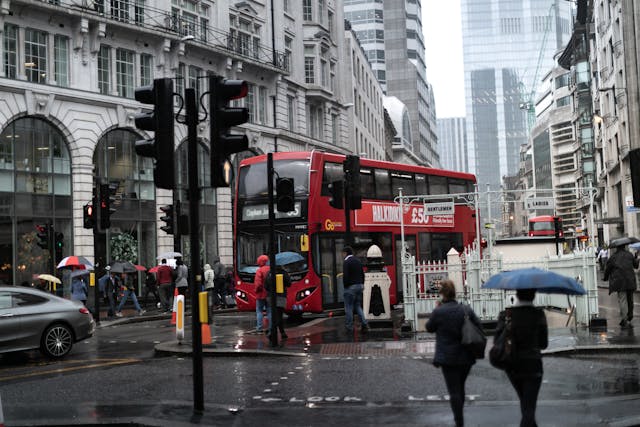
The London commercial market has entered 2025 on an upswing. After a period of uncertainty due to changing remote and hybrid work arrangements, occupiers are displaying renewed confidence, driving demand for both premium office spaces and flexible workspace options.
If you’re planning to set up an office in London, or want to upgrade your office space within the city, you’ll want to know how the capital’s office market is evolving this year. In this article, you’ll find an overview of the key trends across the London commercial real estate landscape.
Snapshot of the London Office Market
Take-up volume and rental rates on the rise
2025 started on a positive note for the London office market, after registering the second highest take-up volume of the last five years and a strong upward trajectory in rental growth rates for Grade A offices.
Renewed interest in large office units
So far, nearly 90% of all transactions involved offices under 25,000 square feet. At the same time, leases for large offices of 75,000 square feet and above are back on the table and at their highest levels since 2019. Appetite for larger office floor plates is mostly driven by lower interest rates that are increasing liquidity in the budgets of occupiers.
London leading in data centre space
Market analysts are drawing attention to data centre space, as new supply is expected to reach all-time high in 2025, and London is emerging as one of the main global hubs for data centre space.
Clear preference for premium office spaces
Nearly 70% of all leases in 2024 offices that had undergone redevelopment or refurbishment to high standards; a trend that is set to continue into 2025.
Rents rising in the City, stable in the West End
Prime rents continue to move upward in the City, as averages reached £98 / sq ft and a new record high was established at £122 / sq ft. Grade A rents have also increased and now average £70 / sq ft.
West End averages remain stable both for prime assets (averaging £157/sq ft and with a new record high of £200/sq ft) and for Grade A space (at £95/sq ft).
Downsizing no longer the dominant trend
While downsizing has been a key trend in this market since 2020, currently 54% of central London occupiers intend to increase their office footprint, 18% wish to keep their existing amount of space, and only 16% are looking to decrease it.

Flexible and co-working space trends in London
After a few years of uncertainty post-2020, as companies reassessed their space needs and hybrid working models took over, flexible office space is back as a highly desirable option, incorporating elements of both traditional offices as well as coworking space.
Approximately 10% of the central London office market now comprises flexible spaces, up from 6% in 2019. This increase in availability suits the needs of many occupiers, who are looking to add this type of space to their portfolios.
Central London is now the prime hub for flexible and managed office space activity, concentrating nearly 70% of take-up from operators in this sector.
Enquiries for flexible offices have increased by 14% year-on-year, and are more than 200% above pre-pandemic levels. This surge in demand is matched by a new wave of national and international operators entering the London market, leading to a higher diversification of flex space, and at the same time increasing the number of management agreements as opposed to conventional leases.
Average desk rates are currently close to £515/month, but exceed £1,100/month for the most exclusive flex offices with high-end amenities like on-site fitness centres. Record-high rates for flex space have been achieved not only in the West End, but also in King’s Cross, Shoreditch, and Euston. On the other hand, occupancy levels are at their highest in the City and Southwark, where they’re close to 90%.
Throughout 2025, more flexible inventory is expected to be released into the market, much of which will be repurposed, as transformation is in the plans of many commercial landlords. Nearly 60% are expecting to transition part of their current offer into flexible formats within the next 5 years.
Which areas are growing in popularity?
Traditional office hubs like the City and West End continue to concentrate interest, with the top 5 most enquired locations being Mayfair, London Bridge, Soho, Victoria, and Marylebone.
In terms of take-up, the City leads in popularity with 65% of the total number of transactions, followed by 34% in the West End, and 3% in East London.
At sub-market level, offices in Mayfair, St James, and Soho are in particularly high demand, which has brought vacancy rates down to pre-2020 levels. Moreover, tenants are willing to pay record-high rents in Chelsea, Battersea, Covent Garden, and Victoria.
Outside of central London, Heathrow, Stockley Park, Uxbridge, and Chiswick have the highest annual prime rent growth rates, reflecting a surge in popularity. London’s East and South East, however, continue their historical trend of low activity.

Which factors are shaping the market?
1. Sustainability weighing in final decisions
Environmental considerations are increasingly influencing office design trends and the decisions of occupiers. Demand for BREEAM-certified and energy-efficient buildings has surged, with landlords investing in refurbishments to create offices that achieve green credentials and avoid obsolescence. As a result, approximately 60% of all 2024 transactions involved offices with Excellent or Outstanding ratings.
Moreover, a sign that the market recognises how workplaces contribute to carbon footprints, occupiers are voting with their wallets. Buildings with high sustainability ratings command rental premiums, currently measured at 15% higher than non-certified offices. Availability for best-in-class space with sustainable credentials is down to 0.5% in the City and even lower at 0.3% in the West End.
2. Employment trends
The number of job vacancies is 25% lower than pre-2020 across London, although a different picture emerges in certain sub-markets, like the City / Square Mile, an office-based area where job numbers have increased by more than 135,000 since 2019. Overall, this points to an unequal development of the office market, reinforcing the City as one of the most in-demand locations for office-based companies.
3. Impact of remote work policies
Despite a generalised move towards hybrid working models, London continues to have the highest rates of remote work. The impact on real estate is two-fold: companies that are still reconsidering their space requirements may postpone any relocation plans, but at the same time, flexible workspaces or securing some dedicated desks in a coworking facility could emerge as an interim solution.
Sectors influencing demand for office space in London
There have been no major changes in the average occupier profile seeking office space in London. Currently, Insurance and Finance businesses are the largest occupiers by take-up, with a third of all transactions.
Tech and Media have the second largest share at 16%, with important deals in Bloomsbury / WC1, whereas Professional Services – and in particular legal services – have the third largest share and have been behind a record number of transactions.
The most notable change is the strength of Serviced Offices as an occupier, which, having a 7% share, matches Business and Consumer Services. Serviced office operators are expected to continue growing based on the current demand for modern offices that come fully equipped and with management on-site.

Conclusion
Throughout the rest of 2025, the London office market is expected to adapt in response to current economic conditions, evolving work models, and sustainability imperatives. Demand from business occupiers and the top talent they court for high-quality, well-located, modern workplaces is set to remain strong, with office occupiers willing to pay a premium for redeveloped and energy-efficient buildings. Overall, the trajectory for the year ahead suggests continued momentum, both for traditional offices and for flexible workspaces.
Looking for more insights?
For more information on trends that are affecting London’s commercial property market, the City’s business outlook, and advice on creating environments that put your employee satisfaction at the forefront, check out some of our other market reports and articles:
Return to Office: UK Workers Surveyed About RTO Mandates
Office Christmas Party Ideas: Not the Traditional, Boozy ‘Do
The Most Haunted Places in London, England: Office Buildings Edition
Gen Z in the Workplace: A Comprehensive Guide
The Benefits of Having Plants in the Office
Cycling to Work in London: Bike-Friendly Office Locations
London Office Market Report 2024
Office Design Trends in Central London Office Space
